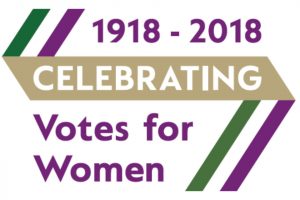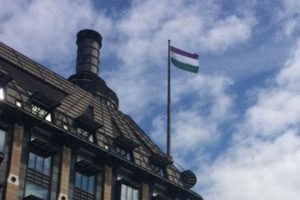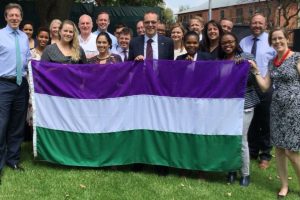
Over 100 years ago, women were conspicuous by their absence from our polling stations and could not stand as candidates for Parliament.
 2018 is the year when the nation remembers and celebrates those brave and resilient individuals who played a role in securing a woman’s right to vote. Many know the story of Emily Davison, who died from her injuries after being knocked down by the King’s horse at the Epsom Derby in 1913. But there are other little-known stories of hunger-striking Suffragettes who sustained lifelong injuries from brutal force-feeding with tubes.
2018 is the year when the nation remembers and celebrates those brave and resilient individuals who played a role in securing a woman’s right to vote. Many know the story of Emily Davison, who died from her injuries after being knocked down by the King’s horse at the Epsom Derby in 1913. But there are other little-known stories of hunger-striking Suffragettes who sustained lifelong injuries from brutal force-feeding with tubes.
The bravery was not limited to women. Frederick Pethick Lawrence (who added his wife Emmeline Pethick’s surname to his own when they married), used his wealth, legal training and journalism skills to assist the suffrage campaign. He was one of a number of men imprisoned and forcibly fed alongside suffragettes.

Year on year, my mum would explain that women died so I could vote. I know from talking to friends that this is the kind of story that gets passed down, almost as a female rite of passage.
This year marks the centenary of the Representation of the People and Parliament (Qualification of Women) Acts of 1918. They gave the vote to women aged over 30 with property, and permitted women to stand as candidates and be elected as MPs. This was a significant milestone in the hard-fought suffrage campaign, which continued up until 1928, when women finally won the vote under the same terms as men.
Following the 2017 General Election, we now have the most diverse Parliament in British history:
- we have our second female prime minister;
- there are more women MPs than ever before – 208 of them in fact, which is 32% of the Commons; and
- in local government, women now make up 33% of elected positions.

We want Parliament to truly reflect the public it serves, which would mean 331 of all MPs being women. So, while there is progress that we should celebrate, there is still more to do.
My team manage the Government’s £5 million Suffrage Centenary pot, which we are using to fund events and activities throughout the year. We want to create opportunities to remember the sacrifice and success of the suffrage activists and celebrate their achievements. And we want to create a sense of national pride in our history and use this moment to raise awareness about how democracy works.
The fund is contributing to:
- the first ever statue of a woman in Parliament Square – of women’s rights campaigner Millicent Fawcett;
- the Women’s Vote Centenary Grant Scheme – making funds available to local and community groups in England;
- providing financial support to exciting projects in 7 cities with strong links to suffrage; and
- establishing a number of programmes to increase the democratic engagement of younger people.
Our centenary year plans are truly cross-government. Colleagues in departments and agencies are planning some excellent events in government buildings. Keela Shackell-Smith is leading the Civil Service plans, and will be writing about them here shortly. You can follow @XgovCentenary to keep up to date with arrangements.

We start with an event on 7 February focusing on 100 years of women in public service. At this event the Suffragette flag relay will be launched and will travel (with an ‘event in a box’) to departments and agencies throughout the UK. You can track the flag’s progress on Twitter @SuffrageFlag. In parallel, FCO and DFID are running a Global Flag Relay. Sir Simon McDonald posted a picture on Twitter from the first location - Pretoria, South Africa.
The celebrations end on 14 December, when government buildings - as many as possible - will be lit in the green, white and violet colours of the women’s suffrage movement to celebrate the centenary of the first set of women’s votes. Interestingly, the Suffragettes knew all about branding and, as well as insisting their colours should be on all products, the initial letters of the colours ‘G’reen, ‘W’hite and ‘V’iolet stood for ‘Give Women Votes’.

Beyond government, many other sectors are marking and discussing the centenary. You may have heard about Celebrity Big Brother: Year of the Woman on Channel 5, which began this month with an all-female group of participants before men were involved (progress of sorts). Meanwhile, The Royal Mint has produced a new 50p piece celebrating the centenary of women’s suffrage.
Major exhibitions about suffrage history will open across the country, from The People’s History Museum, in Manchester, to The Museum of London. BBC1 will screen a 90-minute documentary on women’s suffrage history; and an Antiques Roadshow special will be looking for suffragette gems hidden in your attic. Out on our city streets, statues of suffrage pioneers will be unveiled in Leicester, Manchester and London.
While it is great to celebrate figureheads, such as Millicent Fawcett and Emmeline Pankhurst, the strength of the Suffrage movement lay in the ‘foot soldiers’ who each had a story to tell and who put their lives on the line. We will be highlighting the stories of individual women who have led the charge for a fair and equal society throughout the last 100 years. The more we can give prominence to those stories, the more we can truly reflect and respect the diversity of strength and courage in our country.
What can you do?
When the flag comes to your building, do get involved in the range of activities on offer.
If you are involved in a community group or charity, please consider whether your organisation would be eligible to apply for funding through the centenary scheme.
Get involved in events in your area – and keep an eye on our website. This will signpost you to events across the country.

9 comments
Comment by Rhonda Bigwood posted on
uncanny coincidence - Taylor Pankhurst, (direct descendant from the Pankhurst's) was doing work experience at HMRC East Croydon on the 6th February, which was his 15th birthday and also the 100th anniversary of the signing of the Act giving woman the vote. He was born in St Thomas hospital London, which over looks Parliament. His sister was born in the same hospital on 4th July.............
Comment by Anne Clay posted on
For anyone interested in learning more about this subject ( and many others), for free, check out the website for Furure Learn - https://www.futurelearn.com. I'm currently doing a course called 'Beyond The Ballot ' about the suffrage movement. I highly recommend it.
Comment by Shelley Smith posted on
Regarding the comment left by Peter Kavanagh above - the reason there are so many more men in parliament is nothing to do with suitability I imagine. It's much more likely due to plain and simple sexism! Sometimes you have to resort to more drastic measures to address an imbalance.
Comment by Chris Lamb posted on
We should not be cajoled into believing that the popular struggle for democracy in the UK started with the suffragists/ suffragettes and that universal suffrage simply came about through the largesse of a couple of Acts of Parliament. The Representation of the People Act 1918 and the subsequent Act of 1928 was essentially the end of an often violent and bitter struggle between the State and excluded social groups which spanned back to the late 18th century. We should never forget, for example, the Peterloo massacre of 1819 when peaceful working class protesters, including men, women and children, were mercilessly cut down in Manchester for seeking to extend democratic rights.
https://www.bl.uk/romantics-and-victorians/articles/the-peterloo-massacre
Comment by Stephen Hemingway posted on
The greatest barrier prior to 1918 was in fact the behaviour of some of the ladies involved. Some followed peaceful resistance, but there was a visable minority who believed committing criminal damage would assistance their cause. The biggest success they actually had was their behaviour in the war. Their contribution on the home front was vital and proved they were just as good as men.
Comment by Gill posted on
Great article, an interesting read. It's a little known fact though that 1918 was not the first time that women could vote in this country. Until 1832, the only criteria defining who could vote was related to wealth so in theory women could vote if they were wealthy enough. In practice few women were in fact wealthy enough due to other restrictions on employment, education and inheritance. The so-called Great Reform Act of 1832 extended the vote to the middle classes, but specified that only men could vote. Of course this piece of historical trivia does not detract from the massive achievement in 1918 that put women on the road to equal suffrage or the very justifiable celebrations.
Comment by Andrea Gillard posted on
I absolutely love this post. Thank you for adding the extra, less known, elements for those who are unaware.
I am involved in the Civil Service Flag Relay and am leading the involvement for the MOTUS Women Entrepreneurs Networking group that I am a member of http://www.motus.org.uk
Comment by Peter Kavanagh posted on
This article says we should have 331 women MP's in the Commons. Wouldn't it be better to have the right people as MP's, those who can actually do the job, instead of implying we need a better 'split' of men and women. Whether it's a majority of men or women in parliament, does it matter as long as they are suitable.
Comment by Barry McAuley posted on
North West Tonight on BBC1 had a week of nightly live broadcasts (6 to 10 February) from the area of Manchester where Emmaline Pankhurst grew up and the house she actually lived in.